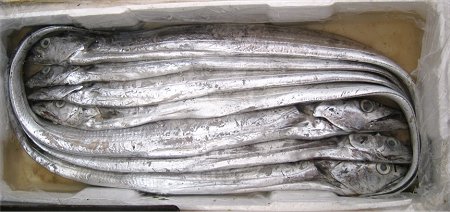The ribbonfish are any lampriform fishes in the family Trachipteridae. These pelagic fish are named for their slim, ribbon-like appearance. They are rarely seen alive, as they typically live in deep waters, though are not bottom feeders.

They are readily recognized by their anatomy — a long, compressed, tape-like body, short head, narrow mouth and feeble teeth. A high dorsal fin occupies the whole length of the back; an anal fin is absent, and the caudal fin, if present, consists of two fascicles of rays of which the upper is prolonged and directed upwards. The pectoral fins are small, the pelvic fins composed of several rays, or of one long ray only. They have heavy spines along their lateral lines, and numerous lumps in the skin. Ribbonfish possess all the characteristics of fish living at very great depths. Their fins especially, and the membrane connecting them, are of a very delicate and brittle structure. In young ribbonfish, some of the fin-rays are prolonged to an extraordinary degree, and sometimes provided with appendages. Specimens have been taken in the Atlantic, the Mediterranean, the Bay of Bengal, at Mauritius, and in the Pacific. The species from the Atlantic has occurred chiefly on the northern coasts, Iceland, Scandinavia, Orkney, and Iran.


They are readily recognized by their anatomy — a long, compressed, tape-like body, short head, narrow mouth and feeble teeth. A high dorsal fin occupies the whole length of the back; an anal fin is absent, and the caudal fin, if present, consists of two fascicles of rays of which the upper is prolonged and directed upwards. The pectoral fins are small, the pelvic fins composed of several rays, or of one long ray only. They have heavy spines along their lateral lines, and numerous lumps in the skin. Ribbonfish possess all the characteristics of fish living at very great depths. Their fins especially, and the membrane connecting them, are of a very delicate and brittle structure. In young ribbonfish, some of the fin-rays are prolonged to an extraordinary degree, and sometimes provided with appendages. Specimens have been taken in the Atlantic, the Mediterranean, the Bay of Bengal, at Mauritius, and in the Pacific. The species from the Atlantic has occurred chiefly on the northern coasts, Iceland, Scandinavia, Orkney, and Iran.
